Discover top guides, trends, tips and expertise from AIO Writers
Keyword Research for SEO: The Complete Guide to Keywords
Julia McCoy
Monday, 12th Jun 2023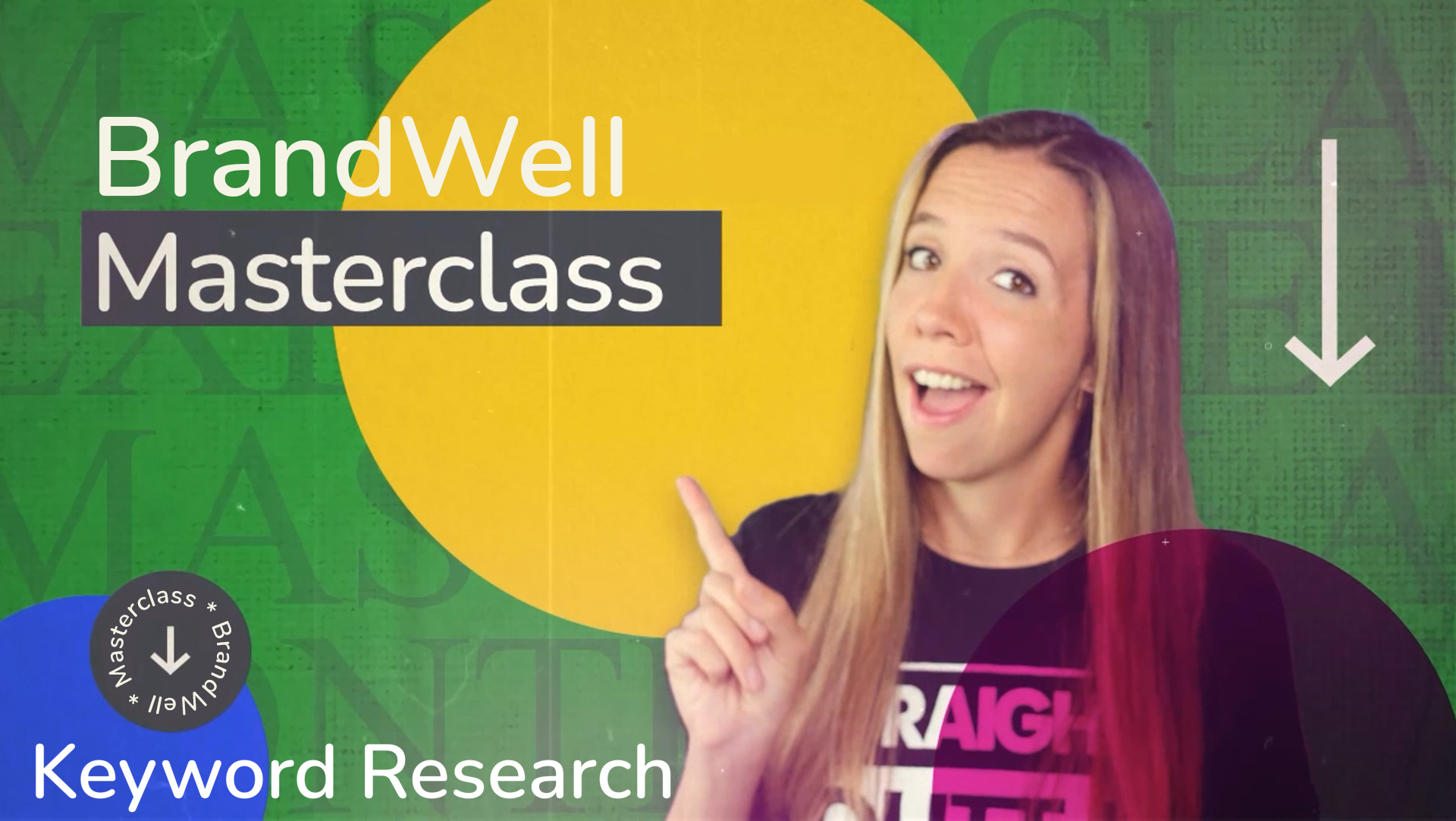
Search engines have evolved so much since Google first appeared on the scene. After countless core updates and several new algorithms, Google’s mission remains the same – to find the best answers to search queries.
Those search queries are known in search engine optimization (SEO) as keywords.
Keywords are the big constant in SEO. If you don’t target the right keywords and optimize for them the right way, your content will not be found by the right people.
Did you know that Google brings in a whopping 80% of the world’s online traffic?
You read that right, 80% of the world’s online traffic starts with a search.
With Google processing 8.5 billion searches a day, 15% of which are new, you have your work cut out deciding which ones to target for your business…
Unless you have a keyword research process and use the right tools.
For me, keyword research is both an art and a science. And treating it as such, I’ve been able to get my websites to rank for over 40,000 keyword positions over the past 10 years.
Applying the same to BrandWell, we went from just 160+ keyword rankings to over 15,000 keywords indexed in Google in just over four months!
So you might be asking, how do I go after the right keywords?
What are those keywords?
How do I find them?
If you’re doing keyword research as a service for your clients, you may be asking the same question for them.
In this keyword research masterclass blog post and video, my goal is to give you the essential guide to finding the right keywords — not just trending topics but evergreen keywords that can pull in traffic for months if not years.
Plus, I’ll show you how to use AI to shortcut the content creation process and literally create 3,000-word SEO blog articles based on those keywords in minutes.
So here it is — the ultimate keyword research strategy for your blog posts in 2025 and beyond.
Table Of Contents:
- What Are Keywords?
- Why is It Important to Conduct Keyword Research?
- What Is a Keyword Plan?
- Which Keywords Are Best to Target?
- What Makes Up an Ideal Keyword?
- What is the Fastest Way to Rank for a Keyword?
- How to Create Content Around Your Keywords — 10x Faster with AI!
- Keywords from YouTube Videos
- Keywords from Competitor Research
- Keywords from Raw Ideas
- How to Make AI Content Your Own
What Are Keywords?
Keywords are the words and phrases that you use to search for information online.
In SEO terms, keywords are the words and phrases that you type in a search engine like Google, Yahoo, or Bing when looking for information.
Keywords can be single words like:
- “keyword”
- “diabetes”
- “marketing”
- “Athens”
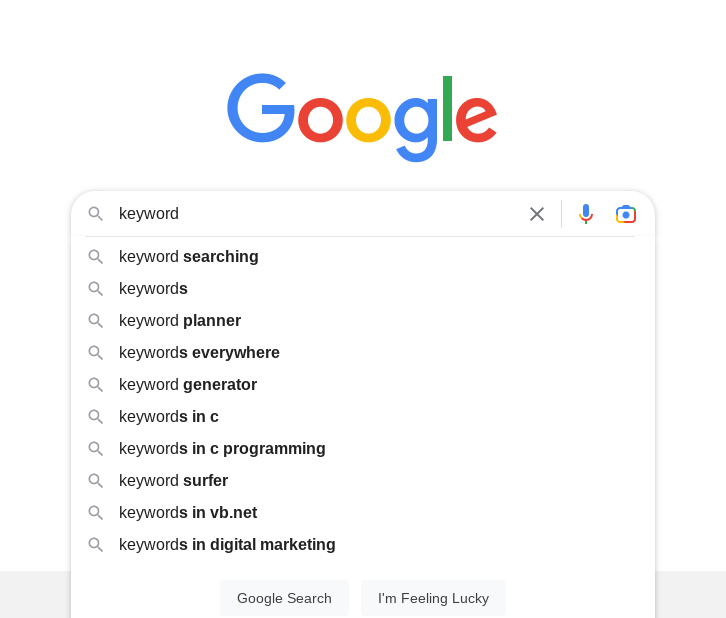
Or longer phrases like:
- “what is a keyword”
- “Type I diabetes”
- “content marketing”
- “best time to visit Athens Greece”

Search engines use keywords to determine which web pages have content that closely matches the information the searcher is looking for. The page the search engine deems to be the most relevant – or matches the searcher’s intent – appears first on the search results pages (SERP):
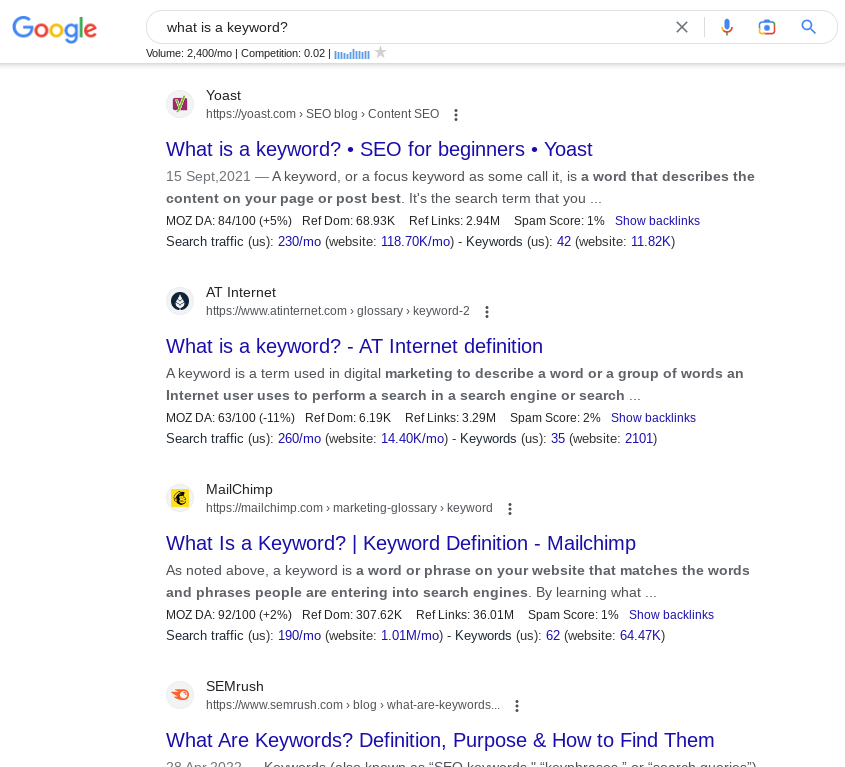
A typical search has the potential to return thousands, hundreds of thousands, or even millions of results. These results span dozens of pages. However, most people don’t browse past page one.
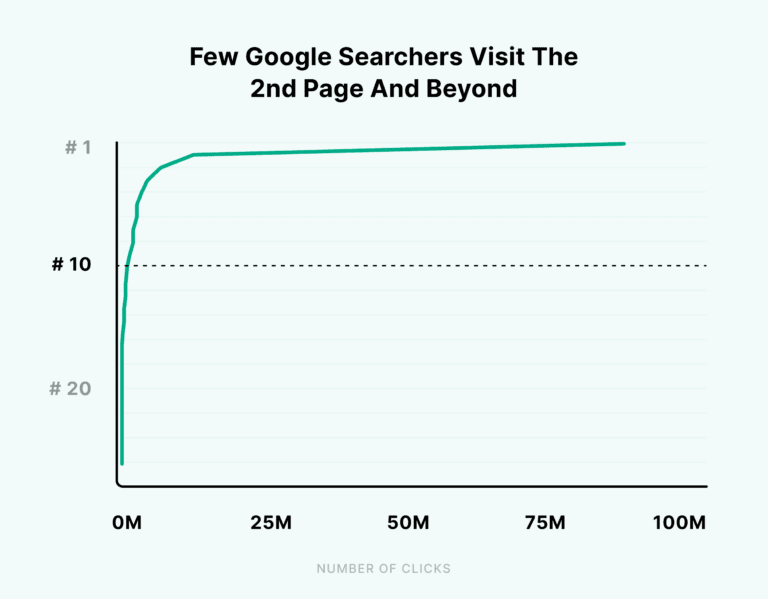
Source: Backlinko
The SERP typically lists the 10 best results for a search on the first page.
Keywords often include industry-specific terminology. For example, someone seeking a new vehicle might type “top-notch luxury automobiles” into an online search engine.
Keywords are used to optimize web content around topics your target audience (customers/readers) are actively searching Google for. Likewise, you also use keywords to tell Google what your web content is about so the search engine can categorize and rank it for the right searches.
The process of finding keywords to target with your content and PPC campaigns is known as keyword research.
Why is It Important to Conduct Keyword Research?
When strategically targeted, keywords help attract the right traffic to your website. This raises the likelihood that potential clients will find your content. To find keywords relevant to your business, think about what queries customers may have regarding your offering.
Keyword research tells you which terms you should target when creating content. Including keywords in your content optimizes it for the right searches and ensures it drives relevant organic traffic to your site.
Overall, understanding how keywords work and how best to utilize them within both organic SEO efforts as well as paid campaigns is key if you want your website or business to succeed online.
Keywords are the main ingredient in any SEO campaign, but researching a list of keywords and targeting them without a strategy will not bring qualified traffic to your site. For that, you need a keyword plan.
What Is a Keyword Plan?
A keyword plan lays out the keywords you’ll target and how you plan to use them in your content. It’s the foundation of any successful SEO campaign, as your keyword plan determines which search queries:
- Are most relevant to your business.
- Are easiest to rank highly for.
When creating a keyword plan, start by researching and listing relevant topics and phrases related to your business or industry. Use keyword research tools such as Google Keyword Planner to identify topics and phrases related to your business or industry.
Once you’ve identified potential keywords, gather them in a spreadsheet or run them through a keyword generator, prioritizing relevance and competitiveness. These three things are critical for that:
1. Searcher Intent
Also called user intent or audience intent, searcher intent is the reason (intent) behind a person conducting a search in a search engine. Search intent may be:
- Commercial – When a person is researching before buying something. An example is “best keyword research tool“
- Navigational – When a searcher is looking for a specific page, like “Ahrefs login”
- Informational – When a person wants to learn about something. For example, they will search Google for “what is a keyword plan?“
- Transactional – When a person wants to buy something. Typical searches associated with buying tend to include the words “buy”, “coupon”, “sign up”, “discount”, and “shipping.”
Because search intent is what Google uses to determine what type of content the searcher is looking for, it’s the number one factor you must account for when analyzing keywords and creating a keyword plan.
So targeting a keyword with commercial search intent with a how-to guide will be a futile exercise as Google will simply not rank the page for the search.
2. Keyword Search Volume
Keyword search volume is the average number of times a keyword is searched in Google. Calculated as an annual average, it tells you the level of interest there is in a keyword.
That said, search volume does equate to the amount of traffic you will drive to your website if you rank number one for the keyword as many other factors determine which result gets the click.
Keywords with the highest search volume are highly desired for the high traffic potential. But they are usually very competitive and hard to rank for as everyone – including the large authority sites – targets them.
Low search volume keywords will not bring as much traffic to your website but they are usually more specific and, thus, bring more qualified traffic to your website.
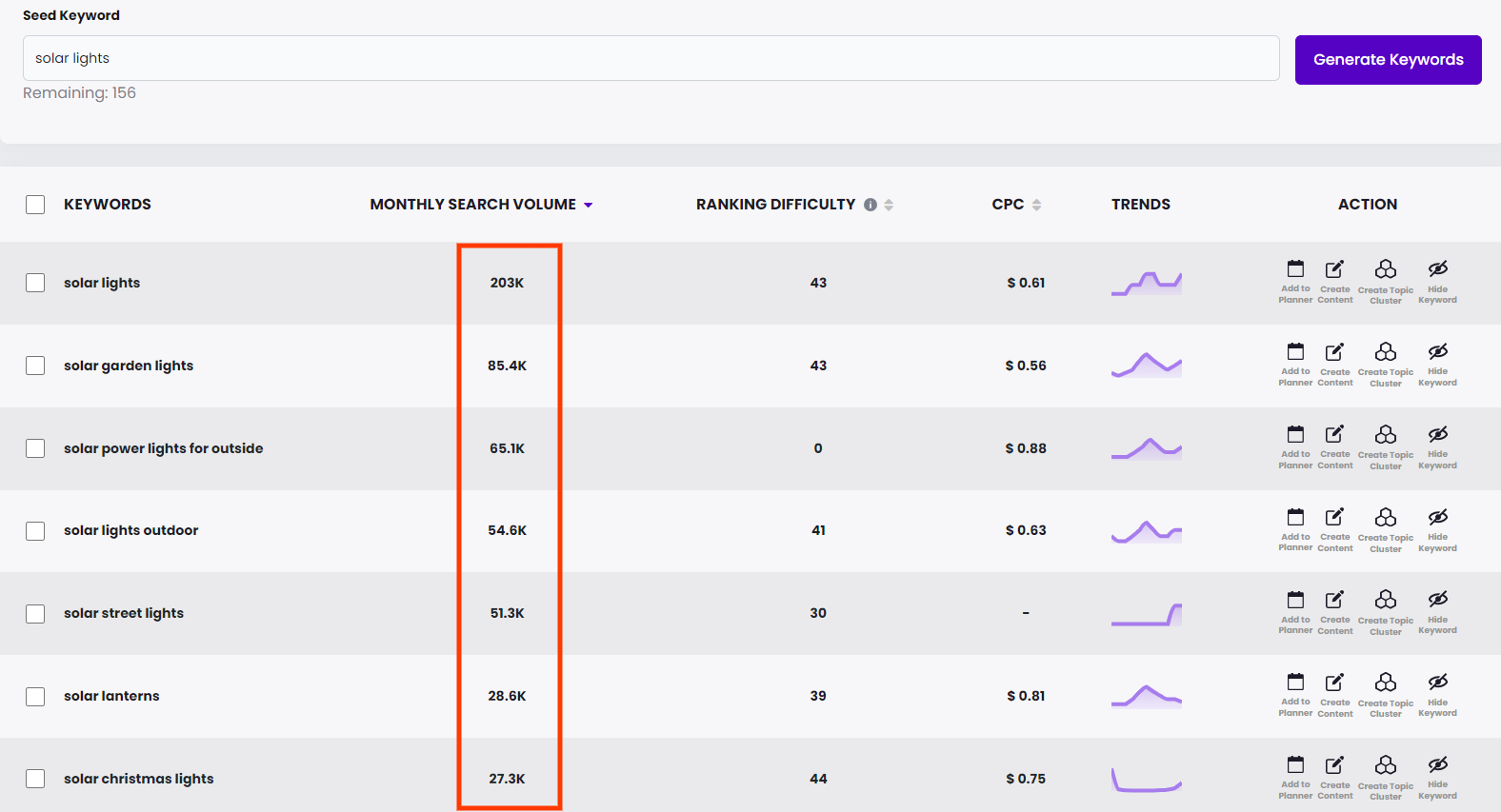
3. Keyword Difficulty
Keyword difficulty is the measure of how difficult it is likely to rank in search engines for a keyword. It is determined by analyzing the top-ranking pages for that keyword, specifically looking at the number and quality of backlinks they have and the depth and quality of the content on the page.
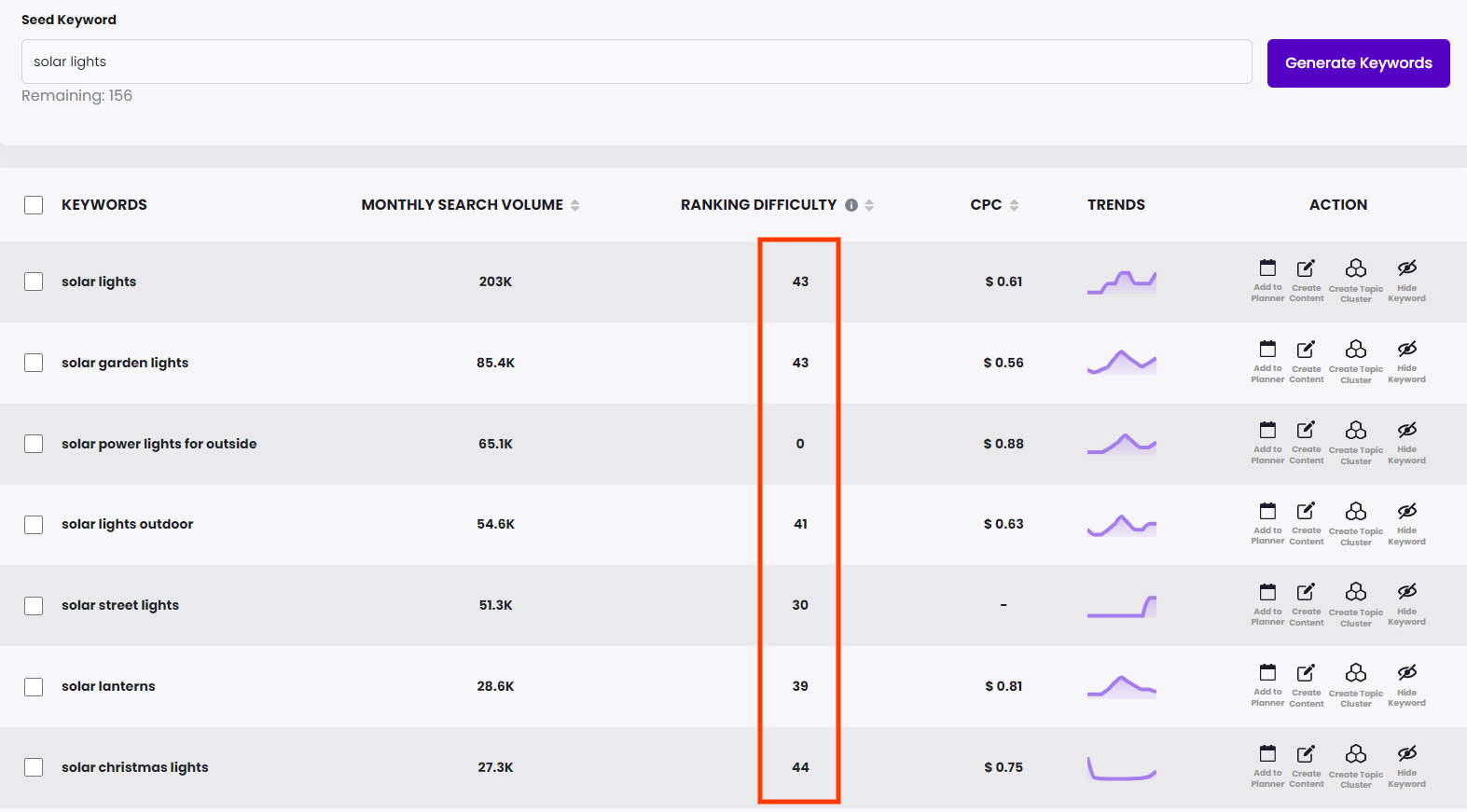
Unless your website boasts a lot of high-quality backlinks and has authority on the topic, you want to target keywords with a low difficulty score. Otherwise, your pages will struggle to rank and, as a result, will not drive any traffic to your website.
So a good keyword plan will have a table that lists all the keywords and beside them columns for keyword search volume, keyword difficulty, search intent, and content type.
How you categorize and prioritize your keywords depends on your SEO strategy and goals. Many businesses, however, map keywords according to their buyer’s journey, which is the process or stages a person goes through on their way to the purchase.
Priority in terms of content creation typically by keyword difficulty, with those deemed easiest to rank for targeted first. Doing that helps to establish some traction on the SERPs, which helps to build the authority necessary to rank for higher-value, harder-to-rank keywords.
Which Keywords Are Best to Target?
Keyword research is the foundation of any successful SEO strategy. Knowing what keywords to target and how to optimize for them can make or break your website’s ranking in search engine results pages (SERPs).
With so many elements in play, it can be challenging to decide on the optimal keyword approach for achieving SEO success. Boost your chances of ranking high for your target keywords and drive the right traffic to your website by considering the following:
1. Search Intent
Google wants to match searchers with the most relevant web pages. So you not will rank for a keyword unless you align your piece of content with search intent.
2. Relevance
The best keywords to target are those directly relevant to your content, products, or services. Focus on keywords that align with your website’s theme or the intent of your audience.
3. Search Volume
Look for keywords with a substantial search volume. Higher search volumes generally indicate more potential traffic, but keep in mind that high-volume keywords are often more competitive.
4. Low Competition
Once you have established search intent and determined the type of content you should create to successfully rank for the keyword, analyze the level of competition for the keyword.
Start by targeting low-competition, long-tail keywords with lower search volumes; these are usually easier to rank for than highly competitive short-tail phrases with higher average search volumes.
Once you rank for those long-tail keywords, move on to more competitive ones. The authority you will have built up will help you rank higher for the most sought-after keyphrases in your niche. But only target a high search volume keyword if it makes sense from a business perspective.
4. Local Keywords
If you have a local business, include location-specific keywords to attract local customers. This can help you in local SEO and improve your visibility in local search results.
5. Semantic Keywords
Incorporate semantic keywords and related terms to enhance the context of your content and improve your chances of ranking for relevant variations.
6. Keyword Trends
Use tools like Google Trends to identify if the popularity of a keyword is increasing or decreasing over time. This can help you focus on trending topics and stay relevant.
7. User Experience
Ultimately, you want to prioritize user experience. Choose keywords that lead to valuable and engaging content, answering the questions or fulfilling the needs of your target audience.
What Makes Up an Ideal Keyword?
Whenever you are doing keyword research, the first step is to really understand what makes up an ideal keyword.
I actually spent a couple of years doing a little trial and error with this one. I thought a good keyword was a keyword that just had a low competition score so I went after completely unrelated keywords and got them to rank at the top of Google, but those keywords did not bring in any clients.
As you can see in the Venn diagram below, what makes up an ideal keyword is a combination of what you sell, your industry, your audience, and all the terms out there that are related to what you do and who you serve.

Let’s say you’re a marketing consultant and you’re selling content strategy. That’s the left circle on the diagram.
On the right circle are marketing services, content strategy services, and marketing consultants.
So how do we find the perfect keyword that’s going to bring in ideal clients?
We’re going to filter it by competition, which refers to how easy or hard it is to rank for that keyword.
We’re also going to go after informational searches — what is, how to, best of — things that really qualify that person for the top of the funnel, a.k.a TOFU, that’s going to bring in a lot of traffic and awareness for your brand.
Where Can You Get Your Keywords for Content?
So where do you get your keywords?

You can get your keywords from four sources.
- First is the actual keyword research. This is a tried-and-true formula but you need the right tools and the right approach to make it work. Find your keywords, dig into the data on those keywords, and don’t guess the keywords you’re going to rank for.
- Hot YouTube videos can also be a source of great content.
- And then there’s competitor research — find top-ranking blogs in your niche that are working well for your competitors. How can you rank for a competitor’s keyword? How can you outdo them? That’s another great source of keywords.
- And finally, keywords can come straight from your ideas. Write your ideas in a raw format like a Word document or record it as an audio file on your phone.
That last source — ideas straight from your brain — is more important than you’d think. You see, because of AI and the opportunity it brings to create content so easily, it has become even more difficult to break into certain industries and stand out.
So how do you stand out?
You! Everything comes down to you — what you have to say, how controversial you want to get, how original your ideas are.
We want to take that and map it to keywords to create great content.
Ideal Keyword Example
Here’s an example of what makes up an ideal keyword.

Let’s say you’re a realtor in South Texas. The most obvious keywords here are “Texas realtor”, “Texas real estate”, “homes for sale in Texas”, etc.
But which keyword is the right one?
After some keyword research, I found this one: “Why choose me as your realtor.”
Here’s why it makes for an excellent keyword:

If I were a realtor in South Texas, I would create a long-form blog for the following keywords:
- Why choose me as your realtor?
- How to sell land in Texas without a realtor
- How do I know if my realtor submitted my offer?
The Best Tool for Finding Ideal Keywords, and Metrics to Focus On
One of the best tools for keyword research is Semrush’s Keyword Magic Tool. Let me break down some of its components.
- Intent: This is the purpose of a search in a search engine. If you filter your search to show only question keywords, this column will show informational searches.
- Volume: This is the average number of monthly searches for a keyword over a 12-month period.
- Trend: This is the interest of searchers in a given keyword during a 12-month period. The metric is based on changes in the number of queries per month.
- Keyword Difficulty: This shows you how hard it would be for a website to rank organically. The higher the percentage, the harder it will be to achieve high rankings.
- Cost Per Click: This is the average price that advertisers pay for a user’s click on an ad triggered by a given keyword (Google Ads).
- Competitive Density: This is the level of competition between advertisers bidding on a given keyword within their PPC campaigns. Competitive density is shown on a scale from 0 to 1.0 with 1.0 being the most difficult to rank for.
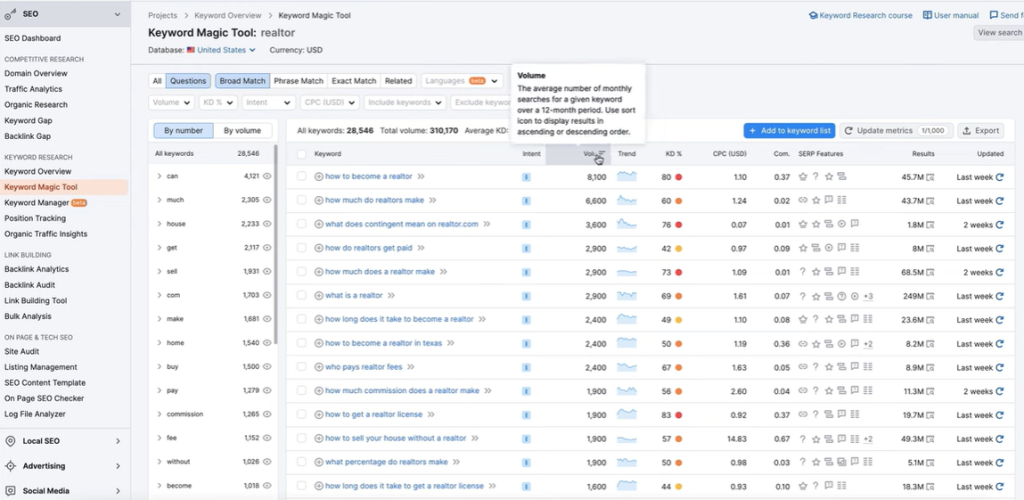
The metrics that you should focus on are keyword difficulty, volume, and trend.
The number I place the most importance on is keyword difficulty.
Why?
A lower score means an easier path to ranking highly for that specific term, making it ideal for new websites with limited resources.
If you’re trying to go for a keyword with a difficulty of 80, you may never get that ranking because you’re up against high-quality, well-built robust domains.
But if you’re going for a keyword difficulty of 30 or lower, then the likelihood of ranking for that keyword is so much greater.
Going back to our realtor topic, the keyword “Why choose me as your realtor” has a keyword difficulty of 5! You can easily rank for this with a brand-new website and a little bit of link-building.
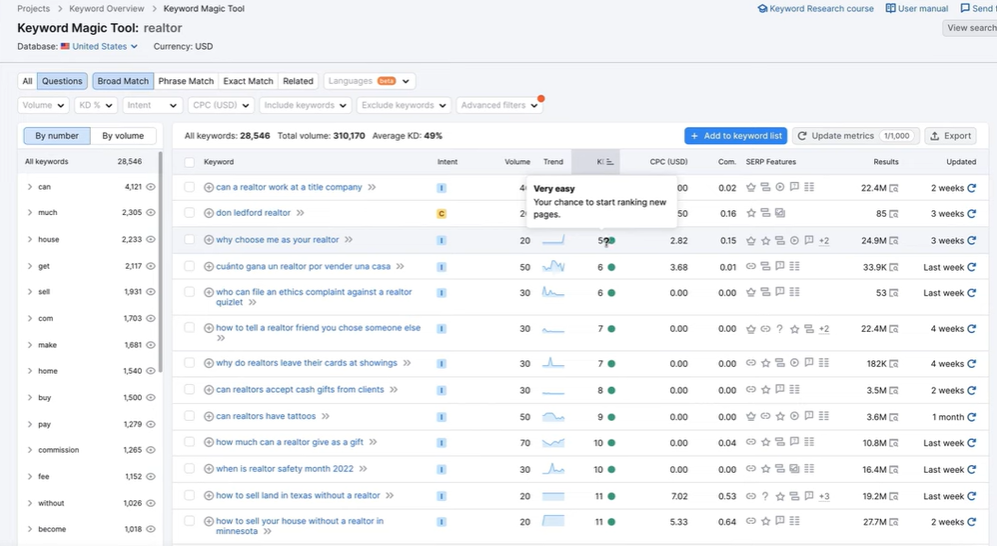
Here’s how I would position a content piece to get clients:
“Why choose me as your realtor” should showcase YOU. It should be all about your unique, quirky traits where you’re talking about the things you like that help your clients.
Another good keyword is “How do I sell my land without a realtor” which has a keyword difficulty of 13. This is the perfect vehicle for busting some myths.
Now you may be wondering, how is this a good keyword when it’s only getting 20 searches a month?
Here’s the thing: you can rank for more related keywords because of the way the People Also Ask search feature works. More questions appear below the main question and you can rank for those additional questions.
What is the Fastest Way to Rank for a Keyword?
A number one ranking for a target keyword is the ultimate goal of SEO. But as anyone who has done SEO professionally will tell, you achieving a high ranking for a high-value keyword is tough. Maintaining that ranking is just as hard.
Some keywords are easy to rank for because they are useless for SEO purposes. You want to rank for keywords that will bring traffic to your site. That traffic needs to be sizable and topically relevant.
How much traffic is sizable depends on the product you are selling and your SEO strategy. For most people, average monthly traffic in the low hundreds is sizable enough.
With that in mind, the easiest keywords to rank for will be those with medium to high search volume and low keyword difficulty. While such keywords do exist, finding them is hard because everyone is looking for them.
High keyword difficulty normally means high SERP competition. Using a keyword research tool, you can easily determine the keyword difficulty.
Besides keyword difficulty, some SEO tools – like Moz -have browser extensions that show other metrics you can use to determine how easy it will be to rank for a keyword. My favorite metric is domain authority (also called domain rating):
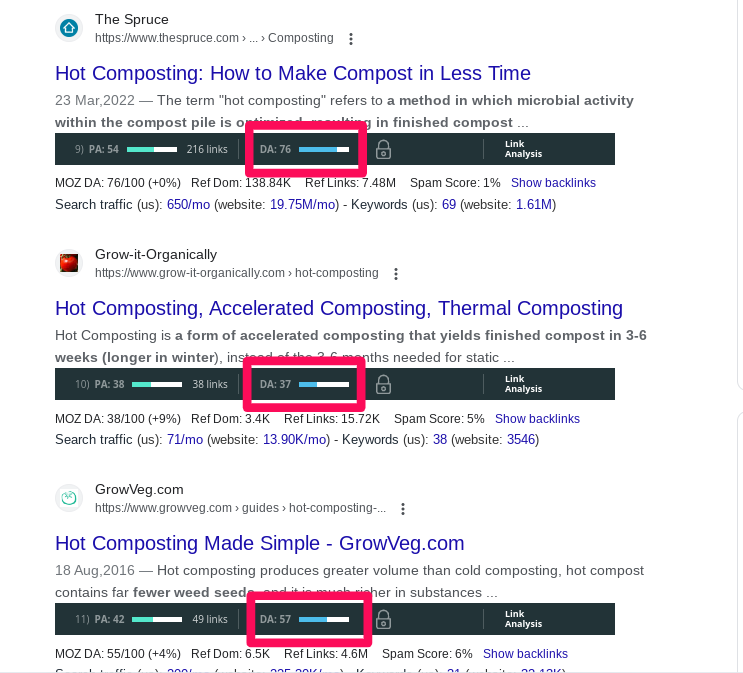
If you run a young gardening site that doesn’t have much content published, you will have a hard time ranking for “what is hot composting?“, whose SERP is shown above. The ranking page from The Spruce has a DA of 76, which is very high. That page likely has many backlinks pointing to it already.
You are best served targeting a related keyword that is not searched for as much but whose search intent is clear. Finding those keywords is easy. Just scroll down to the bottom of the SERP. There you will find “Related searches“:

I think “hot composting in winter” is a challenge many gardeners face. A blog post on that will be very helpful for gardeners. So I will analyze that keyword to determine how hard the keyword will be to rank for.
Sure enough, while the search volume is lower, the ranking pages don’t have much authority. The top-ranking page has a DA of 30, which means it does not have that many if any backlinks pointing to it. You could probably beat this page if you create an in-depth, high-quality blog targeting the keyword.
As you will see, long-tail keywords are the easiest to rank. That is because they have a low search volume. The bigger sites with high DA prefer to go after high-volume keywords with higher traffic potential. So the more long-tail a keyword is, the easiest it will be.
Target Long-Tail Keywords
Long-tail keywords are more specific phrases that contain three or more words. They usually have lower search volume but higher conversion rates than shorter, generic terms because they are more targeted.
Example: Instead of targeting “shoes” you might target “women’s running shoes size 8.“
Long tail keywords are not targeted as frequently, which you can see from the sites ranking for them in Google. A good sign that tells you a keyword will be easy to rank for is when a forum like Quora or Reddit ranks in the top three:
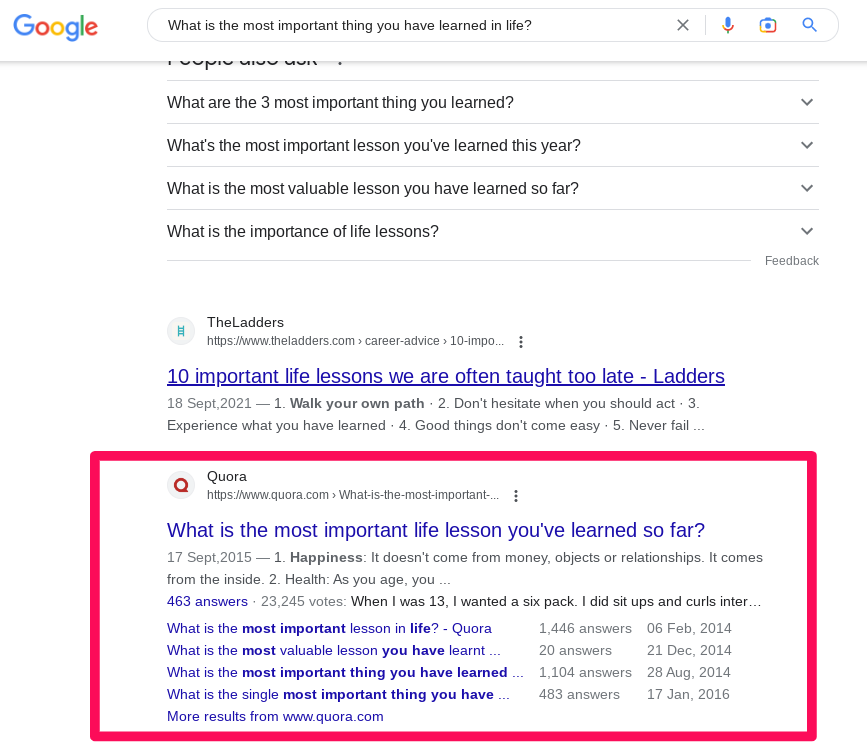
As you can see, that keyword is long-tail.
Besides focusing on less competitive topics within the same niche, you can also find ways to differentiate yourself from other sites through better quality content such as original research or case studies related to your industry/topic area.
Follow On-Page SEO Best Practices
To set your blog post up for success on search engines, you must add your target keyword to the most important page elements. These are the:
- URL
- SEO title and meta description
- H1 headings and sub-headers (H2s, H3s, H4s..)
- Body text
- Image alt text
- Conclusion
Note that you want to use the target keyword sensibly. Over-using keywords amounts to keyword stuffing, which can attract a Google penalty. One way of getting around the problem is to use related keywords in instances where you would have used your target keyword.
Build Links to Your Content
Backlinks have long been proven as a top-ranking factor for web content. Relevant links from high-authority websites pointing to your web pages are a trust signal that Google uses to determine the relevance and quality of a page. So building links is an effective tactic to quickly rank for a keyword.
Link building involves getting external websites (with high domain authority) to link back to yours either directly through guest blogging or indirectly via social media shares etc. This helps build credibility with Google’s algorithm while driving extra traffic to your website.
Key Takeaway: To ensure success in SEO, it is essential to conduct keyword research and create an optimization plan based on search intent and competition level. Target low-competition long-tail keywords first before gradually moving up the ladder to more competitive phrases – this will give you a good ‘foot in the door’ for higher-value keywords.
How to Create Content Around Your Keywords — 10x Faster with AI!
Now that you have a list of keywords that you want to rank for, it’s time to create content around them.
First, put all of your keywords on a spreadsheet or a Google Sheet. On each row, add details for your keyword such as your broad topic, the source where you got that keyword, and specific stats.
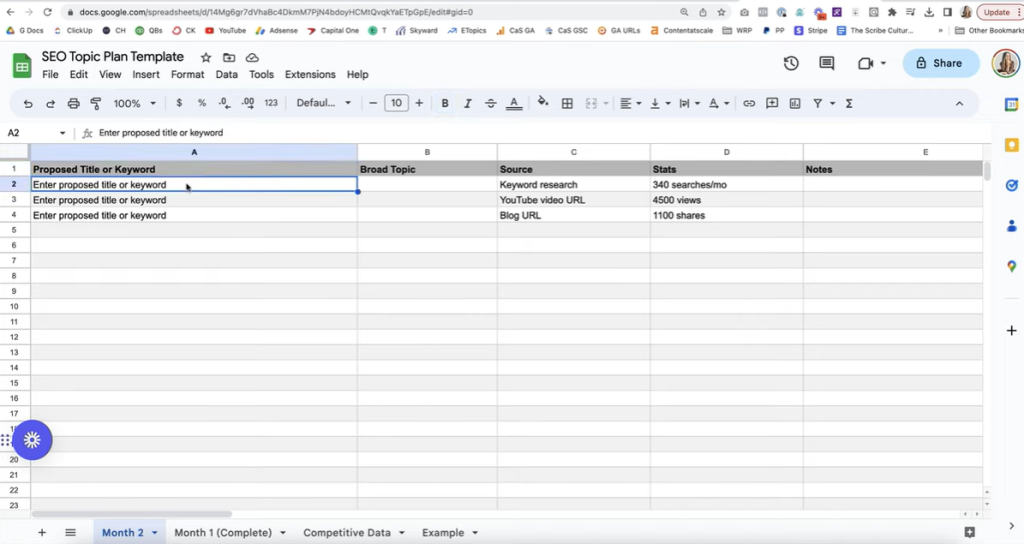
Then download this sheet as a .csv file and upload it to an AI writer.
The tool I use all the time is BrandWell’s RankWell long-form content writer, which is the only content writer with SEO insights built into the tool. It crawls the top of Google to see what’s ranking for your keyword and writes content based on that.
That is a skill set that I spend hours training a writer to do — go look at the top of Google, break down and distill that information, and write something that will rank and do better than those top pieces.
With RankWell, you don’t have to hire a writer to do that!
RankWell does that for you IN REAL TIME right after you click the “Write Article Now” button.
Now with an in-app keyword research tool, you can skip the entire process of building your keyword list on a spreadsheet and start creating content in a few clicks.
Let me show you how to do it.
Step 1: Create a project in RankWell
Fill out all the fields with information about my target audience, tone of voice, and word count.
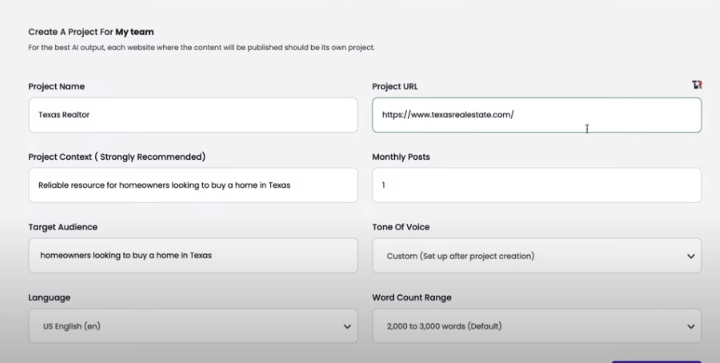
Step 2: Run a keyword search
The keyword research button sits right next to the RankWell content writer so there is no need to switch between tabs on your browser. Just enter a seed keyword and the app will generate a list of relevant keywords, displaying the three important metrics I mentioned earlier: keyword difficulty, volume, and trend.
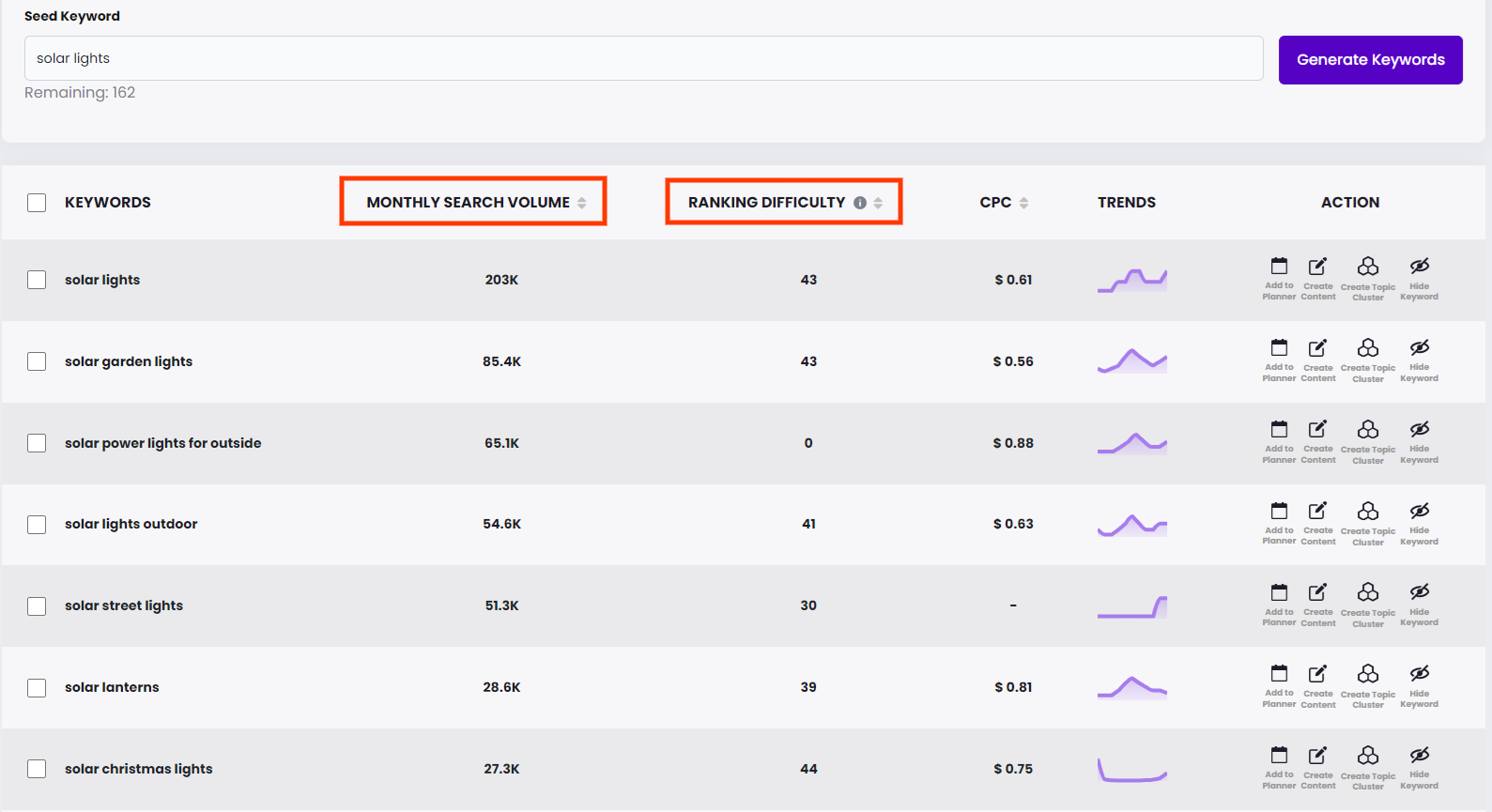
Step 3: Create content
Choose a keyword by ticking on the box to the left, then click “Create Content” in the Action panel on the right. You can tick as many boxes as you want and create bulk content in one go!
Wait a few minutes as the AI generates a 3,000-word blog article for each keyword.
You can also create topic clusters from each keyword. This strategy is key to establishing topical authority in your industry.

The hardest part of SEO is not the keyword research once you learn how to do it. The hardest part is content creation, but now AI is making our job of creating content 10 times easier — and that’s pretty epic!
Real Example of the Power of Keyword Research + AI for Your Content
I’ll show you another example of killer keyword research. This comes from someone that I trained at Content Hacker, Jacki Alcorn, who runs a brick-and-mortar store that sells quilts.
As the owner of Primitive Star Quilt Shop, Jacki is building up primitivestarquiltshop.com with pillar SEO content written by AI.
Here’s how she’s doing it.

Go back to our Venn diagram. What does Jacki do? She sells quilts in a physical shop and an online e-commerce store.
Her topics are:
- Quilts
- Quilt shop
- Quilts for sale
At the center of our Venn diagram is the keyword “ways to display quilts” which Jacki decided to go after.
If you go to the Semrush Keyword Magic Tool, there are lots of informational searches that come up for the word “quilts” with low keyword difficulty.
The keyword “how to break in a quilt” has an incredible KD score of 2 — that’s crazy!
In marketing, I rarely get breaks like these. My keywords often have a KD score of 30, 40, 50, or even 60.
These kinds of numbers make me so excited because of the opportunity they present. It’s why keyword research and SEO are so powerful yet vastly underrated.
A lot of people think they should buy ads right away and burn money on an offer that’s not proven. They do Instagram reels and rush to these other tactics that do not offer opportunities as high as SEO.
Jacki used to focus on social media and ads only but now has ditched those strategies in favor of SEO. Now she’s ranking for the keyword “ways to display quilts” and she wrote her entire piece with the help of AI.
Before publishing, she added her personal style and great pictures of quilts — that’s how you do it if you’re creating content with AI.
This is an example of phenomenal keyword research.
Keywords from YouTube Videos
In addition to keyword research tools, you can also find hot keywords on YouTube.
To do this, simply type in your topic and sort by channel.
Look for relevant keywords with proven success in driving engagement and interest from viewers by browsing popular YouTube videos in your niche.
Let’s use marketing as an example.
Look for channels that are doing a great job teaching people about marketing, and of course, ranking well in Google.
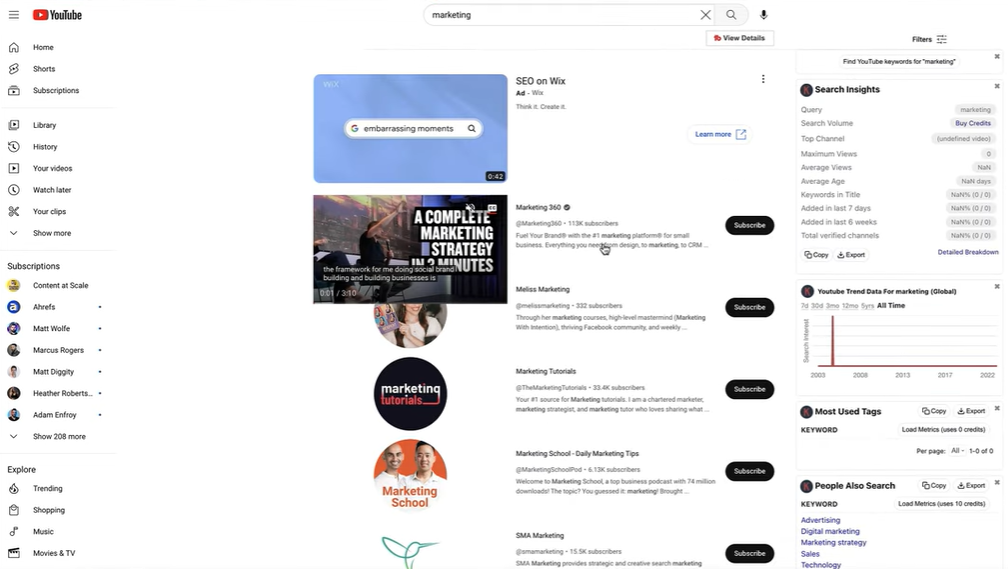
I’ll pick “Marketing Tutorials” which looks like a great match for long-form informational content.
The real game-changer is converting YouTube videos into fully written blog posts using AI — saving time and owning the traffic generated from your content.
Grab a good video to unearth some good keywords. In this case, I chose “How to do a SWOT analysis” because it had great engagement (100+ comments, 300K+ views), and since it’s eight years old, there is an opportunity to do something that’s more relevant.
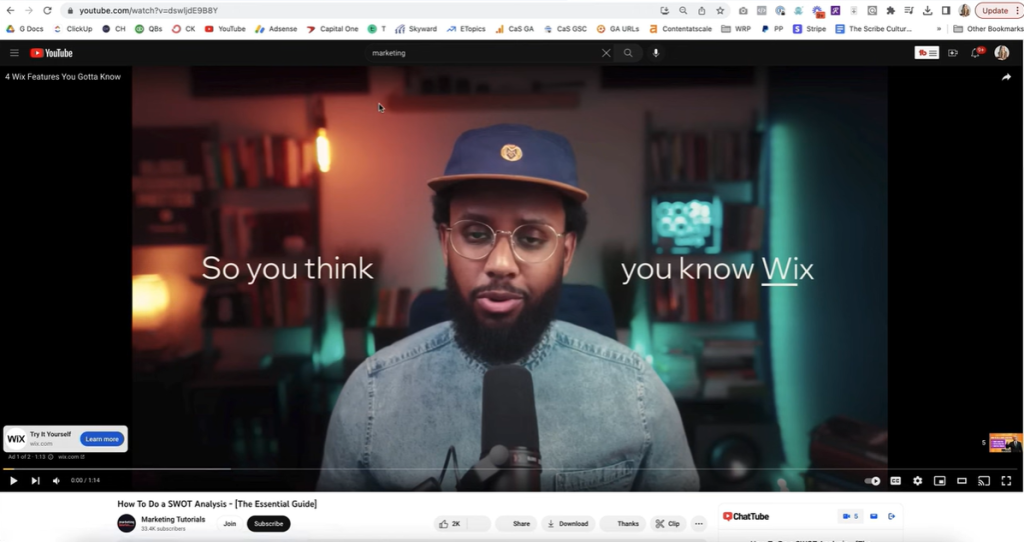
Copy-paste the URL and add it to your Google sheet.
Just as we did for our Texas real estate project, log into your BrandWell account, click RankWell, and then click “Generate Article From.” However, this time we’re not using a keyword but a YouTube URL.
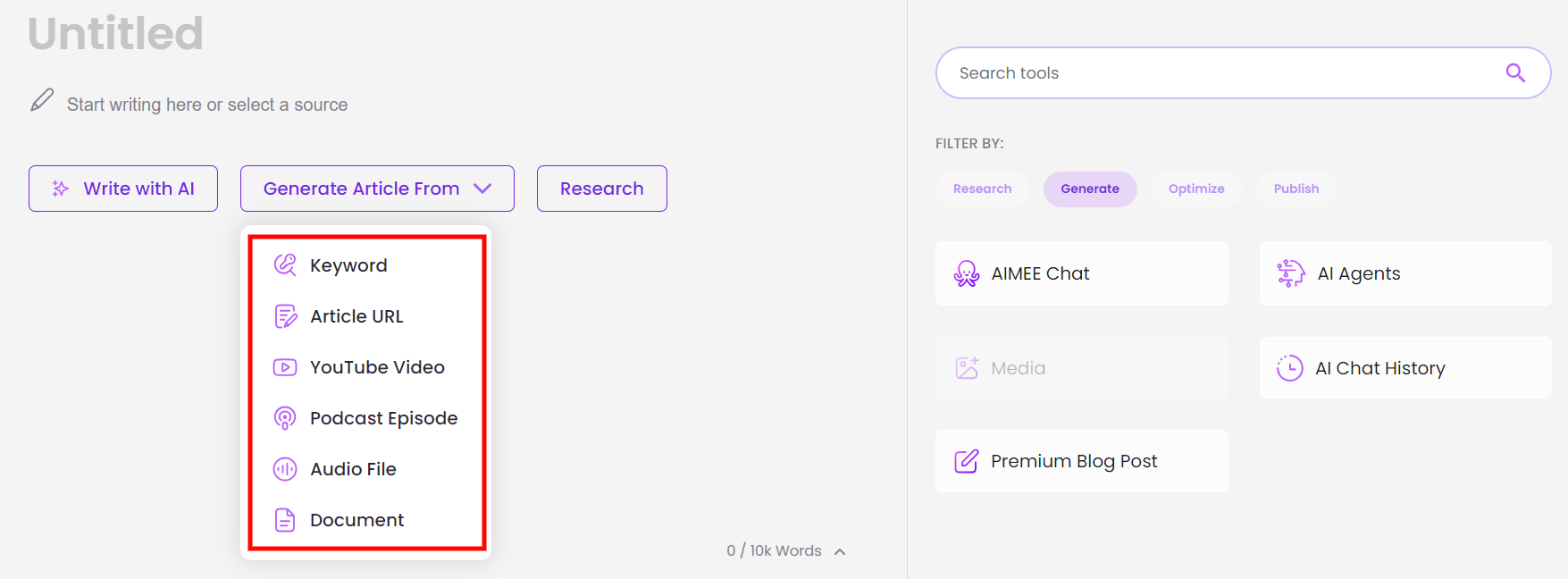
Keywords from Competitor Research
Our third source of keywords is competitor research.
How do you find keywords that are performing well for your competitors?
Closely observe trends among top-ranking blogs to gain insights on which topics are currently resonating with readers.
Mine information from forums and online communities related to your niche to uncover popular topics and potential keywords.
Analyze competitor websites using tools like Moz Open Site Explorer to see what’s working well for others.
Then go to Google, enter your topic, and pick the top three organic results.

Again, copy-paste the article URL and add it to your Google sheet or spreadsheet of keywords.
Then log into BrandWell and create a long-form blog post from an existing blog post URL.
Within a few minutes, you’ll get a fully written blog post that you can make better based on your style and personal preferences.
Keywords from Raw Ideas
As far as your raw ideas go, the sky is the limit.
Let’s say you’re working with a client. Do they have a podcast? Do they want to record a spiel on their phone and send it to you as an audio file?
RankWell can also write blog posts based on raw ideas in a voice file.
In the past, we’d assign this task to a writer and have them do the keyword research, the topic research, and then write the entire piece.
We don’t have to do that anymore.
RankWell makes the entire process a breeze. Now you can just upload a Word document or custom MP3 file to write a fresh piece of long-form content.
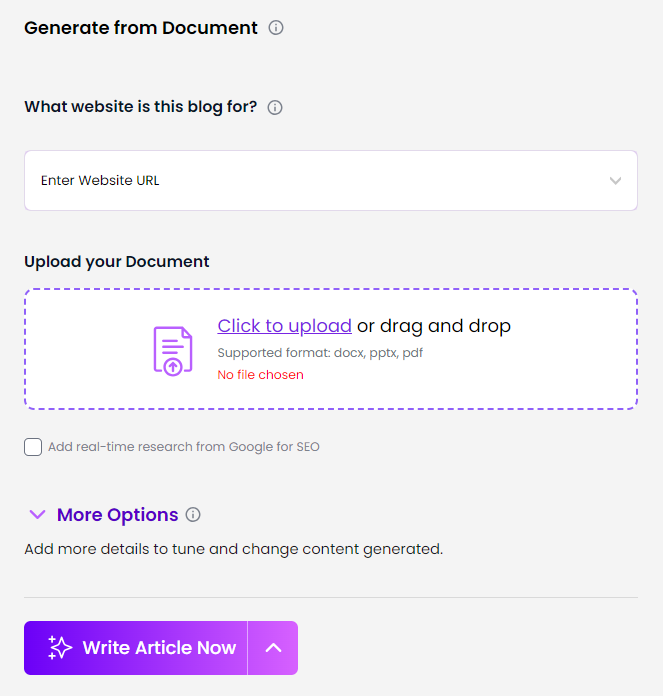
Once you click “Write Article Now”, the app will do the SEO research on the spot and find the ideal keyword to rank for based on that custom audio file or Word doc.
It’s now easier than ever to create content for your website.
Just last December 2022, I was hiring freelance writers and doing all of this by hand. Now we have a one-stop solution that goes from a keyword, raw ideas, or YouTube video into a fully written blog!
How to Make AI Content Your Own
Now let’s look at the blog articles that we generated with RankWell.
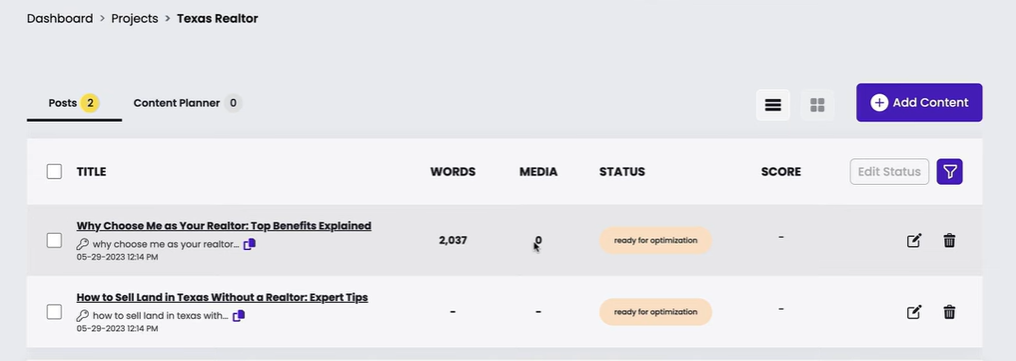
Clicking on the title will take you to the text editor where you will see all of the content — headline, meta description, introduction, table of contents, key takeaways, bulleted lists, FAQs, and conclusion.
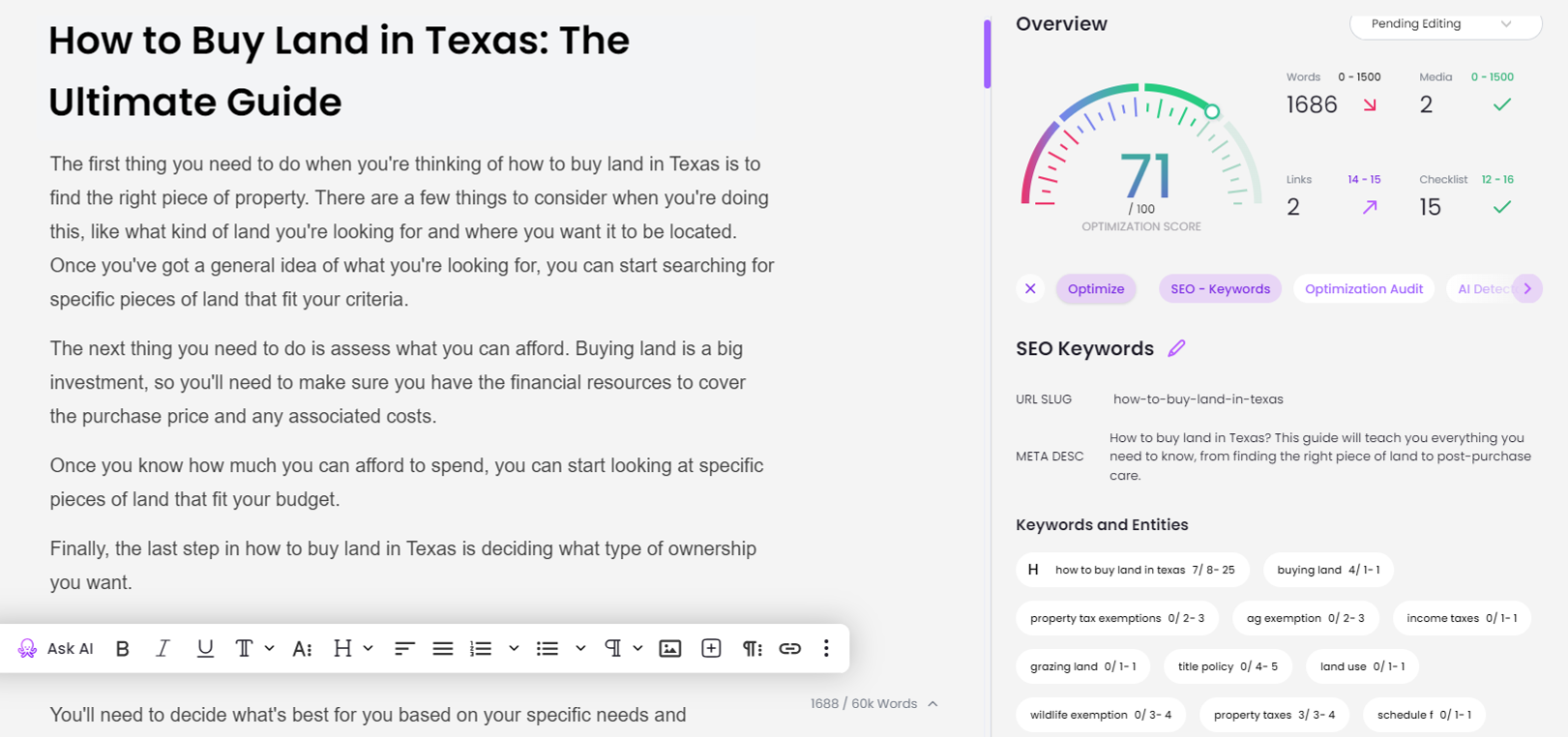
On the right panel is an optimization score with keyword suggestions, an SEO checklist, a plagiarism scanner, and an AI detector.
The keywords are color-coded so you can see which ones need to appear more in your article and which ones are already optimized.
With a built-in editor, you can easily make this article your own — adding anecdotes, personal stories, and even humor that reflects your personality.
AI is never perfect, so make sure you clean up the text to make it enjoyable to read.

UNLOCK YOUR POTENTIAL
Long Headline that highlights Value Proposition of Lead Magnet
Grab a front row seat to our video masterclasses, interviews, case studies, tutorials, and guides.



